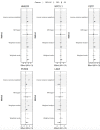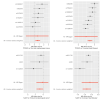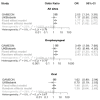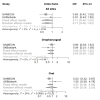Using genetic variants to evaluate the causal effect of cholesterol lowering on head and neck cancer risk: A Mendelian randomization study
- PMID: 33886544
- PMCID: PMC8096036
- DOI: 10.1371/journal.pgen.1009525
Using genetic variants to evaluate the causal effect of cholesterol lowering on head and neck cancer risk: A Mendelian randomization study
Abstract
Head and neck squamous cell carcinoma (HNSCC), which includes cancers of the oral cavity and oropharynx, is a cause of substantial global morbidity and mortality. Strategies to reduce disease burden include discovery of novel therapies and repurposing of existing drugs. Statins are commonly prescribed for lowering circulating cholesterol by inhibiting HMG-CoA reductase (HMGCR). Results from some observational studies suggest that statin use may reduce HNSCC risk. We appraised the relationship of genetically-proxied cholesterol-lowering drug targets and other circulating lipid traits with oral (OC) and oropharyngeal (OPC) cancer risk using two-sample Mendelian randomization (MR). For the primary analysis, germline genetic variants in HMGCR, NPC1L1, CETP, PCSK9 and LDLR were used to proxy the effect of low-density lipoprotein cholesterol (LDL-C) lowering therapies. In secondary analyses, variants were used to proxy circulating levels of other lipid traits in a genome-wide association study (GWAS) meta-analysis of 188,578 individuals. Both primary and secondary analyses aimed to estimate the downstream causal effect of cholesterol lowering therapies on OC and OPC risk. The second sample for MR was taken from a GWAS of 6,034 OC and OPC cases and 6,585 controls (GAME-ON). Analyses were replicated in UK Biobank, using 839 OC and OPC cases and 372,016 controls and the results of the GAME-ON and UK Biobank analyses combined in a fixed-effects meta-analysis. We found limited evidence of a causal effect of genetically-proxied LDL-C lowering using HMGCR, NPC1L1, CETP or other circulating lipid traits on either OC or OPC risk. Genetically-proxied PCSK9 inhibition equivalent to a 1 mmol/L (38.7 mg/dL) reduction in LDL-C was associated with an increased risk of OC and OPC combined (OR 1.8 95%CI 1.2, 2.8, p = 9.31 x10-05), with good concordance between GAME-ON and UK Biobank (I2 = 22%). Effects for PCSK9 appeared stronger in relation to OPC (OR 2.6 95%CI 1.4, 4.9) than OC (OR 1.4 95%CI 0.8, 2.4). LDLR variants, resulting in genetically-proxied reduction in LDL-C equivalent to a 1 mmol/L (38.7 mg/dL), reduced the risk of OC and OPC combined (OR 0.7, 95%CI 0.5, 1.0, p = 0.006). A series of pleiotropy-robust and outlier detection methods showed that pleiotropy did not bias our findings. We found limited evidence for a role of cholesterol-lowering in OC and OPC risk, suggesting previous observational results may have been confounded. There was some evidence that genetically-proxied inhibition of PCSK9 increased risk, while lipid-lowering variants in LDLR, reduced risk of combined OC and OPC. This result suggests that the mechanisms of action of PCSK9 on OC and OPC risk may be independent of its cholesterol lowering effects; however, this was not supported uniformly across all sensitivity analyses and further replication of this finding is required.
Conflict of interest statement
The authors have declared that no competing interests exist.
Figures





Similar articles
-
Association Between Genetically Proxied Inhibition of HMG-CoA Reductase and Epithelial Ovarian Cancer.JAMA. 2020 Feb 18;323(7):646-655. doi: 10.1001/jama.2020.0150. JAMA. 2020. PMID: 32068819 Free PMC article.
-
Associations of genetically proxied inhibition of HMG-CoA reductase, NPC1L1, and PCSK9 with breast cancer and prostate cancer.Breast Cancer Res. 2022 Feb 12;24(1):12. doi: 10.1186/s13058-022-01508-0. Breast Cancer Res. 2022. PMID: 35151363 Free PMC article.
-
Genetic association of lipid-lowering drugs with aortic aneurysms: a Mendelian randomization study.Eur J Prev Cardiol. 2024 Jul 23;31(9):1132-1140. doi: 10.1093/eurjpc/zwae044. Eur J Prev Cardiol. 2024. PMID: 38302118
-
Genetic Association of Lipids and Lipid Drug Targets With Abdominal Aortic Aneurysm: A Meta-analysis.JAMA Cardiol. 2018 Jan 1;3(1):26-33. doi: 10.1001/jamacardio.2017.4293. JAMA Cardiol. 2018. PMID: 29188294 Free PMC article. Review.
-
Testing for causality between systematically identified risk factors and glioma: a Mendelian randomization study.BMC Cancer. 2020 Jun 3;20(1):508. doi: 10.1186/s12885-020-06967-2. BMC Cancer. 2020. PMID: 32493226 Free PMC article.
Cited by
-
The role of lipids and lipids lowering drugs in human papillomavirus (HPV) and HPV-associated cancers.Infect Agent Cancer. 2025 Jan 28;20(1):4. doi: 10.1186/s13027-025-00635-5. Infect Agent Cancer. 2025. PMID: 39876011 Free PMC article. Review.
-
Evaluating the effect of metabolic traits on oral and oropharyngeal cancer risk using Mendelian randomization.Elife. 2023 Apr 12;12:e82674. doi: 10.7554/eLife.82674. Elife. 2023. PMID: 37042641 Free PMC article.
-
Repurposing Statin Drugs to Decrease Toxicity and Improve Survival Outcomes in Head and Neck Cancer.OTO Open. 2021 Dec 11;5(4):2473974X211065715. doi: 10.1177/2473974X211065715. eCollection 2021 Oct-Dec. OTO Open. 2021. PMID: 34917872 Free PMC article. Review.
-
Effect of blood lipids and lipid-lowering therapies on osteoarthritis risk: A Mendelian randomization study.Front Med (Lausanne). 2022 Nov 11;9:990569. doi: 10.3389/fmed.2022.990569. eCollection 2022. Front Med (Lausanne). 2022. PMID: 36438033 Free PMC article.
-
Effect of statin use on head and neck cancer prognosis in a multicenter study using a Common Data Model.Sci Rep. 2023 Nov 13;13(1):19770. doi: 10.1038/s41598-023-45654-7. Sci Rep. 2023. PMID: 37957229 Free PMC article.
References
-
- Saba NF, Goodman M, Ward K, Flowers C, Ramalingam S, Owonikoko T, et al.. Gender and ethnic disparities in incidence and survival of squamous cell carcinoma of the oral tongue, base of tongue, and tonsils: a surveillance, epidemiology and end results program-based analysis. Oncology. 2011;81(1):12–20. 10.1159/000330807 - DOI - PMC - PubMed
-
- Cancer Research UK (CRUK). Head and neck cancer statistics 2019. [cited 2019 11/04/2019]. Available from: https://www.cancerresearchuk.org/health-professional/cancer-statistics/s....
Publication types
MeSH terms
Substances
Grants and funding
- P30 ES010126/ES/NIEHS NIH HHS/United States
- MC_QA137853/MRC_/Medical Research Council/United Kingdom
- P30 CA047904/CA/NCI NIH HHS/United States
- MC_UU_00011/7/MRC_/Medical Research Council/United Kingdom
- MC_UU_00011/1/MRC_/Medical Research Council/United Kingdom
- 220530/Z/20/Z/WT_/Wellcome Trust/United Kingdom
- R01 CA090731/CA/NCI NIH HHS/United States
- RP-PG-0707-10034/DH_/Department of Health/United Kingdom
- MC_UU_00011/7/MRC_/Medical Research Council/United Kingdom
- C68933/A28534/CRUK_/Cancer Research UK/United Kingdom
- WT_/Wellcome Trust/United Kingdom
- MC_PC_17228/MRC_/Medical Research Council/United Kingdom
- 001/WHO_/World Health Organization/International
- 29019/CRUK_/Cancer Research UK/United Kingdom
- P30 CA016086/CA/NCI NIH HHS/United States
- C18281/A29019/CRUK_/Cancer Research UK/United Kingdom
- R01 DE025712/DE/NIDCR NIH HHS/United States
- C18281/A19169/CRUK_/Cancer Research UK/United Kingdom
- P50 CA097190/CA/NCI NIH HHS/United States
- 28534/CRUK_/Cancer Research UK/United Kingdom
LinkOut - more resources
Full Text Sources
Other Literature Sources
Medical
Miscellaneous

